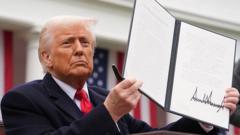President Trump's recent trade agreement with Japan is drawing attention as a potential turning point in his administration's approach to global trade. The deal, which results in Japan receiving a relatively favorable tariff regimen compared to other nations, signifies a minor victory for the tough tactics the administration has employed.
The Trump administration has been vocal about the prospects of reaching a trade deal with Japan, yet has struggled to finalize terms until recently. Observers are beginning to recognize this achievement as a sign that Trump's high-stakes negotiation style may indeed deliver tangible outcomes.
Japan's arrangement stands out, particularly as its 15% tariff on goods exported to the U.S. is higher than the UK's 10%, despite the UK not owning a trade surplus. The negotiations were reportedly intense, with Japanese representatives historically known for their diplomatic approaches displaying notable frustration during talks.
The significance of this agreement cannot be understated; it serves as a monumental example that could influence other economic powerhouses, especially within the European Union (EU). Japan, upon reaching a deal, has effectively undermined calls for a coordinated retaliation among EU members against U.S. tariffs.
Details surrounding the deal are still emerging, but it has been suggested that Japan has secured protections for its agricultural imports while increasing purchases of U.S. rice. As American automobiles remain unpopular in Japan, domestic companies are expected to invest significantly in the U.S. market, potentially amounting to a half trillion dollars.
Interestingly, Japan made this deal during a time when they might have benefited from waiting to assess how Trump’s tariffs would impact the global market. Observers note that Japan’s domestic political considerations may have influenced their decision to finalize this agreement sooner rather than later, as other nations like Indonesia and the Philippines pursue similar arrangements.
The broader implication of accepting these tariffs from the U.S. reflects a trend of allies adapting to a more confrontational stance from Washington. The tariffs, which would have been considered excessive a year ago, have now become a norm as countries seek to avoid more severe economic repercussions.
Currently, tariffs are generating substantial revenue for the U.S. Treasury, contributing over $100 billion this year and accounting for about 5% of federal revenue. Secretary of the Treasury Scott Bessent predicts that this amount could soar to $300 billion annually. However, the implications for U.S. consumers remain pertinent, as the cost of imports is likely to rise significantly due to reduced purchasing power.
Economic experts note that despite speculation regarding the role of a stronger dollar in lessening import costs, the dollar has seen a decline of 10% against other currencies in the first half of the year. This downturn amplifies the costs of both tariffs and imported goods.
The global context further complicates the narrative; experts are observing shifting trading patterns that may alter perceptions of traditional safe-haven currencies like the U.S. dollar. The sentiment in markets suggests a growing hesitance among traders regarding exposure to dollar fluctuations, with efforts underway to hedge against a potential decline.
Overall, while the deal with Japan provides a significant boost to President Trump’s trade policy rhetoric, the larger economic picture remains one of uncertainty and complexity, indicating that this saga of global trade negotiations is far from complete.






















